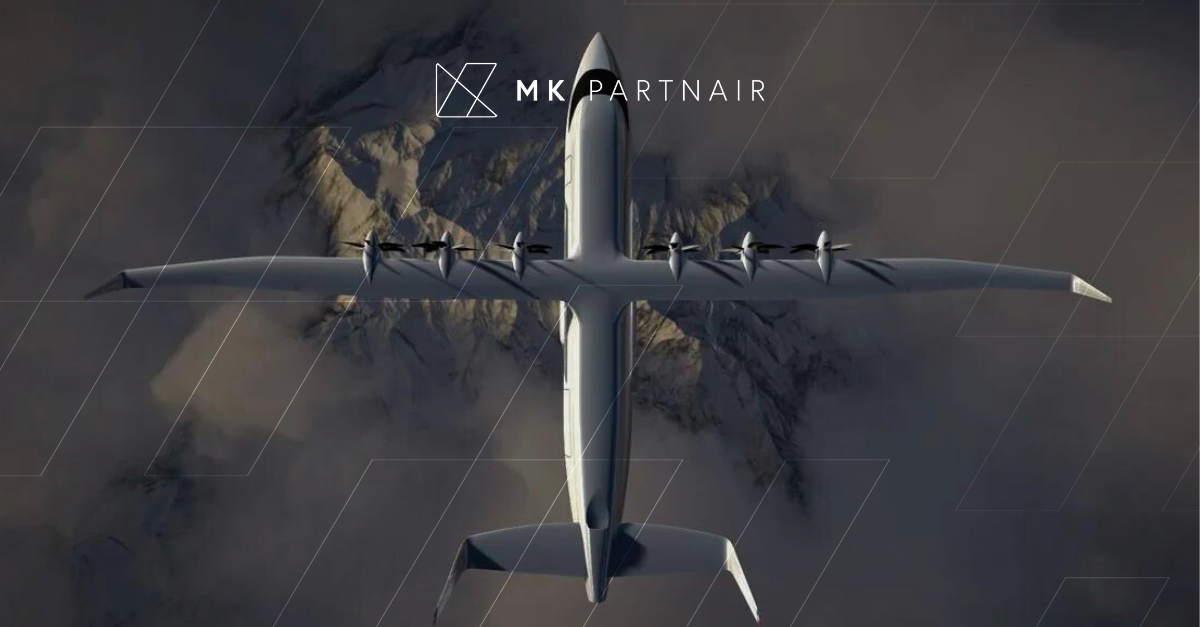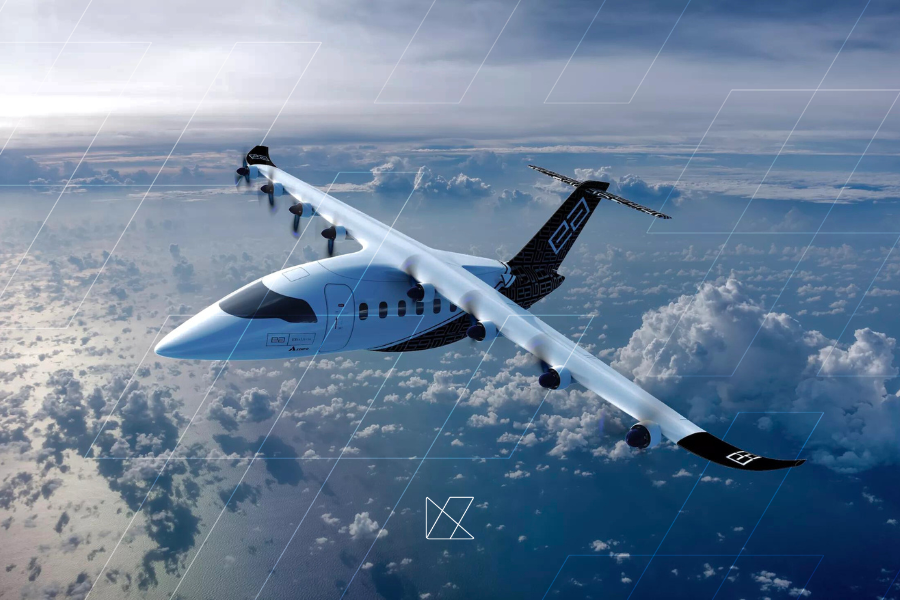MK PARTNAIR AND THE FUTURE OF AVIATION | EVOLUTION, CURRENT STATUS AND PROSPECTS 10/18/2023

MK Partnair is well aware of the environmental impacts of aviation and encourages manufacturers in their efforts to develop greener aviation. Indeed, considering the environmental impact is crucial to meet sustainability standards and international climate agreements. In a world where decarbonization is the order of the day, MK Partnair offers the first available solutions, aims to be vigilant, and closely monitors studies on electric aviation.
As a reminder, the 2023 edition of the International Business Aviation Exhibition (Ebace) highlighted the various technological advancements in business aviation, which continues to reinvent itself to better meet the expectations of users, whether in terms of performance or societal challenges. We have also showcased these innovations in an article we are presenting in this publication.
THE IMPACTS OF AVIATION
Several impacts, such as noise and air pollution, are significant and are taken very seriously in current studies. In terms of emissions, aviation as a whole accounts for 2% of global CO2 emissions. Business aviation, on the other hand, represents 10% of the traffic and 2% of these emissions, equating to 0.04% of global CO2 emissions.
These environmental impacts make aviation a major area of interest in the search for sustainable solutions to reduce the aerospace industry’s environmental footprint. Significant efforts and investments are underway to develop cleaner aviation technologies, reduce CO2 emissions, and minimize all negative environmental consequences. Ultimately, our industry is in constant flux, promising to redefine aviation standards. MK Partnair closely monitors these developments, allowing us to guide you through the progress already made and those yet to come.
To date, and despite the challenges of large-scale production and utilization, MK Experts strive to offer, when available, the use of Sustainable Aviation Fuel (SAF), which is a fuel with multiple values related to environmental responsibility:
- Reduction of greenhouse gas emissions
- Compliance with environmental objectives
- Compatibility with existing aircraft
- Diversification of energy sources
- Improvement of air quality











ELECTRIC AVIATION FOR A BETTER WORLD
The transformation of aviation is an imperative that MK Partnair takes very seriously and aims to integrate for a more sustainable future. In an era where environmental preservation has become a central concern, this transition to greener aviation relies on technological innovation, the search for alternative fuels and energy sources, and more responsible resource management practices.
Advancements in electric aviation, hydrogen, and improved engine efficiency, combined with more efficient use of airspace, are key elements of this transformation.
The ultimate goals are:
- Reduce greenhouse gas emissions
- Minimize noise and atmospheric pollution
- Preserve biodiversity and ensure accessibility to air transport while mitigating its environmental impact
This transformation holds the promise of a future where aviation will continue to play a critical role in global connectivity while making a positive contribution to the planet’s health and a better world for future generations. Electric aviation is a continuously evolving field that embodies technological innovation and the pursuit of sustainable solutions in the aerospace sector.
We’ve received many inquiries from MK Partnair travelers, and three questions frequently arise. Here are our responses:
How does electric aviation work?
Electric aviation relies on the use of electric motors to propel aircraft, rather than traditional internal combustion engines. Here’s how it works:
- Energy storage: Electric energy used in electric aviation typically comes from batteries, although advanced energy storage solutions such as supercapacitors or hydrogen may also be considered. Lithium-ion batteries are commonly used to store electric energy on board the aircraft.
Energy Conversion for Propulsion: The electricity stored in batteries is converted into mechanical energy to propel the aircraft. This is achieved by powering electric motors, typically located on the wings or within engine nacelles. - Electric Propulsion: Electric motors drive propellers or fans to generate the thrust necessary to propel the aircraft forward. Electric propulsion technology can vary, ranging from traditional electric motors to more advanced axial flow electric motors.
- Electronic Control: Electronic control systems manage the power supplied to electric motors, adjusting it according to flight requirements, such as acceleration, altitude maintenance, or deceleration.
- Cooling and Thermal Management: Cooling systems are crucial to maintaining an optimal operating temperature for electric motors and batteries, as heat can impact the performance and lifespan of components.
Electric aviation holds significant potential to reduce carbon emissions and enhance the environmental sustainability of the aerospace industry. However, there are still technical challenges to overcome to improve range, battery capacity, and electric motor performance to make electric aviation viable for a broader range of missions and distances. Indeed, addressing range remains a major challenge.
Where is electric aviation currently at?
MK Partnair has focused (for now) on the manufacturer Airbus, a major player in this field, which is developing a twin-helicopter aircraft. This transition to electrification in aviation represents a significant step towards more environmentally friendly air operations, reflecting our commitment to sustainability and societal issues. Among the models being developed, we can mention the Alpha Electro, the Bristell Energic, and the Alice.
What airport infrastructure is needed to adapt to this new form of aviation?
The development of charging infrastructure for electric aircraft is a key element of the transition to electric aviation. Here are some of the infrastructure developments or existing facilities for charging electric aircraft:
- “Electric” Airports: Some airports are beginning to install charging stations for electric aircraft. These stations can resemble parking gates for aircraft, where the aircraft can be connected for recharging between flights.
- Fast Charging Network: Fast charging networks, similar to those used for land-based electric vehicles, are in development for electric aircraft. They enable rapid recharging during layovers, helping to minimize downtime.
“Electric” Hangars: Some hangars are equipped with charging stations for electric aircraft. These facilities can be used for overnight or between-flight recharging. - Wireless Charging: Wireless charging technology is also in development for electric aircraft. Aircraft can be charged without the need for physical connection to a charging station.
- Solar Infrastructure: Some airports are beginning to invest in solar installations to generate clean electricity for recharging electric aircraft.
- Smart Grids: Smart grids enable better management of energy demand for electric aircraft, optimizing electricity distribution and minimizing operating costs.
- Station Energy Storage Systems: Charging stations may also include energy storage systems, such as batteries, to ensure a continuous supply of electricity even during demand peaks.
- Industry Standards: The development of common charging standards is crucial to ensure that charging infrastructure is compatible with various types of electric aircraft.
It’s important to note that the development of these infrastructures is still ongoing, and it will take time to deploy them on a large scale. However, the initial steps are already being taken to support the growth of electric aviation and enable its broader adoption.
Over the past few decades, electric aviation has gained significance due to growing environmental concerns, the need to reduce greenhouse gas emissions, and the quest for solutions to make air transportation more environmentally friendly. This evolution is the outcome of collaborative efforts among aerospace companies, research organizations, and governments to develop more advanced electric technologies and re-envision the design of traditional aircraft.
THE FUTURE OF BUSINESS AVIATION
Business aviation is a sector where the adoption of electric aviation can bring significant benefits. As previously mentioned, as the world shifts towards more sustainable transportation solutions, electric aviation is emerging as an essential cornerstone. The future of business aviation looks promising with the introduction of electric aviation.
Electric business aircraft promise a reduced carbon footprint, lower operating costs, reduced noise pollution, and greater operational flexibility. Thanks to the absence of polluting emissions and gradually improving range, these aircraft allow access to airports even closer to the destinations of business travelers, thus reducing travel time. Furthermore, electric motors offer simplified maintenance and quieter operation, which is particularly attractive for business flights in urban areas.
Many manufacturers are aiming to develop efficient and widely available charging infrastructure, necessary to realize this vision of a future where eco-friendly flights become an accessible reality for all. As electric technologies continue to evolve and charging infrastructure expands, electric business aviation is expected to play a leading role in providing faster, more efficient, and environmentally friendly travel for business travelers of the future.
Electric aviation has garnered increasing interest in recent years, and massive investments in its research and development are turning this vision into reality. Key areas of investment in electric aviation include:
- Research and Development (R&D): Major aerospace companies such as Airbus, Boeing, and specialized electric aviation startups have invested heavily in R&D to develop cutting-edge technologies, including electric motors, energy storage systems, and power management systems.
- Charging Infrastructure: Investments are being made to build electric aviation-appropriate charging infrastructure, including fast charging stations at airports and hangars equipped with charging systems.
- Pilot Projects and Prototypes: Pilot projects and prototypes of electric aircraft have been funded to demonstrate the feasibility of this technology and test concepts in real-world conditions.
- Government Support: Many governments have launched electric aviation support initiatives, offering grants, tax incentives, and research programs to encourage the development of this technology.
- Private Investors and Venture Capital: Numerous startups working on electric aviation have attracted venture capital investments, enabling them to fund their research and development activities.
- Industry Collaborations: Alliances between aerospace companies, airlines, and electric component manufacturers have emerged to accelerate the development of electric aviation solutions.
- Training and Education: Investments have also been made in workforce training and education to support the transition to electric aviation.
All of these investments reflect the commitment of the aerospace industry and governments to promote electric aviation as a viable solution to reduce the carbon footprint of aviation and enhance environmental sustainability.




At MK Partnair, we are committed to staying at the forefront of this evolution by exploring and integrating these innovative technologies into our strategy for a greener and more responsible aviation future. While we look forward to the opportunity and luxury of traveling in the aircraft of the future, our team remains at your service: sales@mkpartnair.com.









